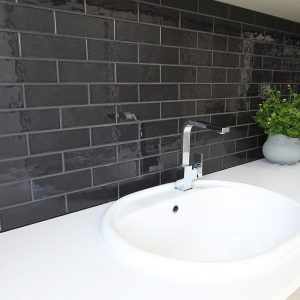
A feature wall is a unique in that it differs from the other walls in the room, usually in pattern, colour, or finish. It can add pzazz to a room that could otherwise be flat or boring. For bathrooms, homeowners may run into a problem finding a balance between design and functionality. A bathroom feature wall need to withstand hot and humid conditions without compromising style. Using bathroom tiles is an excellent way to hit that perfect balance of style and function.
Range of Tile Options
Ceramic, porcelain, glass, marble, and more — there are plenty of different types of bathroom tiles to pick from for your unique bathroom feature wall. Here’s a few, just to get you started.
Ceramic Tiles
The most common bathroom tile comes in several colours, sizes, textures, and styles to suit any design. They’re perfect for DIY homeowners, since they’re easy to install and maintain. Best of all, they’re moisture resistant making them perfect for your bathroom. You can really add a dramatic flare to your bathroom and create a mosaic or go subtle and have a single colour. The possibilities are endless.
Porcelain Tiles
Porcelain tiles have an elegant finish and do not fade or crack. They go well in almost any room, are durable and sturdy.They are also non-porous, which makes them highly resistant to staining and moisture. With dedication to installation and upkeep, the finished product can be breathtaking, especially when used on a bathroom feature walls.
Glass
With superior stain resistance and easy upkeep, glass is a great choice. They’re also more suited to walls than to flooring, due to the possibility of chipping.
Marble
Marble adds a level of sophistication to any room, especially in smaller applications.
Matt, Gloss, Glaze, Satin?
Surface finishes are just as important as the type of material chosen for the tile. Glazed and gloss finishes are shiny, slippery, and reflective, which makes them excellent for bathrooms, and they are available in an array of colours, textures, and styles. Satin finishes are the middle ground between matte and gloss tiles, are less reflective than glazed, and are easy to clean and maintain. Matte finishes are soft to the touch, not reflective, durable, and easily combined with gloss or satin finished bathroom tiles for contrast.
Design and Implementation: Bringing It All Together
There are tons of ways to use bathroom tiles to brighten up and stylise a room that’s not typically thought of as “stylish”. Geometric patterns using large, differently-finished tiles adds depth and contrast. Bright, vivid colours can add character and shine. Dark, muted colours can create a sleek and modern look. A combination of several different types of bathroom tiles adds not only functionality, but creativity. You can use straight lines to elongate a room, zig zags and curves to add movement, or solid shapes to establish patterns and stabilise the room. The design is completely customisable because every individual tile element is also uniquely customisable. Where the design goes is up to you–that’s the best part of using bathroom tiles for your feature wall!
Ceramic Tile Supplies in Perth and we have experts that can help you from the design phase all the way to the finishing touches. Need help picking the right tiles for your bathroom feature wall? Visit one of our showrooms today!



















